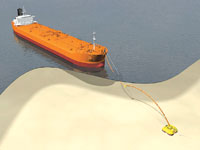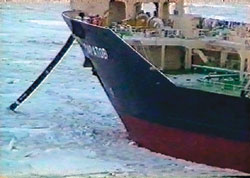 Technology from Europe: Technology from Europe:
Norway/Sweden
First Arctic SAL, shuttle tanker combo operates in Pechora Sea
 |
MSCO’s SAL system has a mooring/fluid swivel that allows the arctic shuttle tanker to rotate freely while connected via a customized, arctic environment loading/mooring hose.
|
|
In recent months, a unique combination of a single anchor loading (SAL) system and two specially built arctic shuttle tankers (AST) has achieved multiple crude oil loadings from northern Russian fields under widely varying conditions in the Timan Pechora Sea. The SAL system is operated by Murmansk Shipping Co. (MSCO) at the Verandey shore terminal, where average water depth is 12 m (39 ft). Area field production is 8,000 bopd and increasing.
Advanced Production and Loading AS (APL) supplied the SAL system to MSCO. Simple in concept, this system includes a single anchor on the seabed, connected to equipment for mooring of, and oil transfer to, an AST (see drawing). Upon arrival, tankers serving the field are moored to the SAL system via a mooring hawser and a connected loading hose.
Typically, the SAL allows the vessel to weather-vane freely while moored. This is accomplished by using a combined mooring/fluid swivel that is directly on top of the anchor. When the AST aligns with the wind and current forces, this imposes a rotation of the combined swivel system.
This particular system was built to rigorous standards, to withstand the Timan Pechora Sea’s harsh arctic environment. The 16-in. loading/mooring hose was specially designed to withstand chafing of ice and mooring forces (see photo).
 |
The shuttle tanker Saratov loads a crude cargo in icy conditions from the SAL system at Verandey on the Timan Pechora Sea.
|
|
As regards the two ASTs, Saratov and Usinsk, they are 20,000-dwt, double-hulled vessels built at the Admiralty Shipyards in St. Petersburg, Russia. Each tanker can carry four grades of cargo simultaneously, including crude oil, oil products, condensate and vegetable oils. When ice is encountered in shuttling to Verandey, each vessel can break up a section as large as 0.5-m (1.6 ft), at a speed of 2 knots.
The ASTs measure 155 m long (509 ft) and 24 m (79 ft) wide, and have a draught of 9 m (29.5 ft). Maximum speed and range are 15.4 knots and 8,000 mi, respectively. Both vessels have APL’s Arctic Bow Loading System (see photo).
On Sept. 27, 2002, the first oil cargo was loaded onto the Saratov via the ASL system. Since then, five additional loadings have been conducted successfully without incident (as of press time). After each loading is completed, the AST completes a round-trip voyage to the port of Rotterdam for delivery to market.
To date, the worst conditions experienced by either AST during loading are 1-m-thick (3.3-ft-thick) ice and a temperature of –32°C (–25.6°F). 
|

 Technology from Europe:
Technology from Europe:


